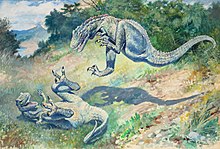Dryptosaurus
| Dryptosaurus Temporal range: Late Cretaceous,
| |
|---|---|
| File:Dryptosaurus.jpg | |
| Scientific classification | |
| Kingdom: | |
| Phylum: | |
| Class: | |
| Superorder: | |
| Order: | |
| Suborder: | |
| Superfamily: | |
| Family: | Dryptosauridae Marsh, 1890
|
| Genus: | Dryptosaurus Marsh, 1877
|
| Species | |
Dryptosaurus (meaning "tearing lizard") was a genus of primitive tyrannosaur that lived in Eastern North America during the Maastrichtian stage of the Late Cretaceous period. A famous painting of the genus by Charles R. Knight has made it one of the more widely-known dinosaurs, in spite of its poor fossil record.
Description


Dryptosaurus was 6.5 m long, 1.8 m high at the hips, and weighed about 1.2 tons. Like its relative Eotyrannus, it had relatively long arms with three fingers. Each of these fingers was tipped by a talon-like 8 inch claw.[1] These claws lend a meaning for the type species aquilunguis: eagle-clawed.
Discovery
In 1866, an incomplete skeleton (ANSP 9995) was found in New Jersey by workers in a quarry.[1] Paleontologist E.D. Cope described the remains, naming the creature "Laelaps" ("storm wind", after the dog in Greek mythology that never failed to catch what it was hunting). "Laelaps" became one of the first dinosaurs described from North America (following Hadrosaurus, Aublysodon and Trachodon). Subsequently, it was discovered that the name "Laelaps" had already been given to a species of mite, and Cope's lifelong rival O.C. Marsh changed the name in 1877 to Dryptosaurus.
Classification
Before the discovery of Appalachiosaurus,[2] it was classified in a number of theropod families. Originally considered a megalosaurid by Cope, it was later assigned to its own family (Dryptosauridae) by Marsh, and later found (through phylogenetic studied of the 1990s) to be a coelurosaur, though its exact placement within that group remained uncertain. The discovery of the closely related (and more complete) Appalachiosaurus made it clear that Dryptosaurus was a primitive tyrannosauroid.
The fossil material assigned to Dryptosaurus was reviewed by Ken Carpenter in 1997 in light of the many different theropods discovered since Cope's day. He felt that due to some unusual features it couldn't be placed in any existing family and warranted placement in its own family, Dryptosauridae.[3] Dryptosaurus was the only large carnivore known in eastern North America before the discovery of Appalachiosaurus.
Paleoecology

Although certainly a carnivore, the paucity of known Cretaceous east coast dinosaurs make ascertaining the specific diet of Dryptosaurus difficult.[1] Hadrosaurus and its relatives have been found in New Jersey as well, so they may have had a prominent part of its diet. Apart from hadrosaurids, nodosaurs were also present although less likely to be hunted due to their armor plating.[1]
References
- ^ a b c d "Dryptosaurus." In: Dodson, Peter & Britt, Brooks & Carpenter, Kenneth & Forster, Catherine A. & Gillette, David D. & Norell, Mark A. & Olshevsky, George & Parrish, J. Michael & Weishampel, David B. The Age of Dinosaurs. Publications International, LTD. p. 112-113. ISBN 0-7853-0443-6.
- ^ Carra, T.D., Williamson, T.E., and Schwimmer, D.R. (2005). "A new genus and species of tyrannosauroid from the Late Cretaceous (middle Campanian) Demopolis Formation of Alabama". Journal of Vertebrate Paleontology. 25 (1): 119–143. doi:10.1671/0272-4634(2005)025[0119:ANGASO]2.0.CO;2.
{{cite journal}}: CS1 maint: multiple names: authors list (link) - ^ Carpenter, Ken & Russell, Dale A, Donald Baird, and R. Denton (1997). "Redescription of the holotype of Dryptosaurus aquilunguis (Dinosauria: Theropoda) from the Upper Cretaceous of New Jersey" ([dead link]). Journal of Vertebrate Paleontology. 17 (3): 561–573.
{{cite journal}}: CS1 maint: multiple names: authors list (link)
- Carr and Williamson (2002). "Evolution of basal Tyrannosauroidea from North America". Journal of Vertebrate Paleontology. 22 (3): 41A.
- [1] - Cretaceous Dinosaurs of the Southeastern United States by David T. King Jr.
